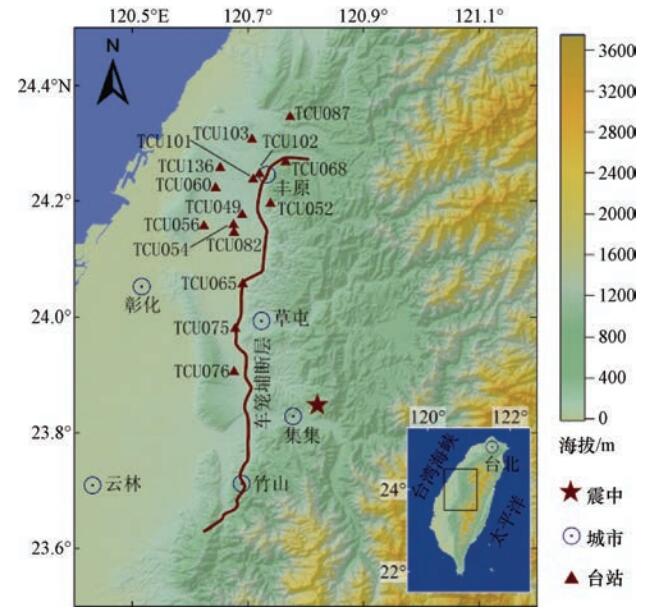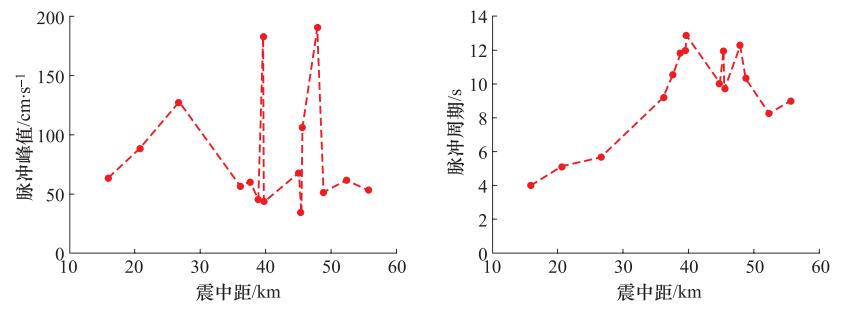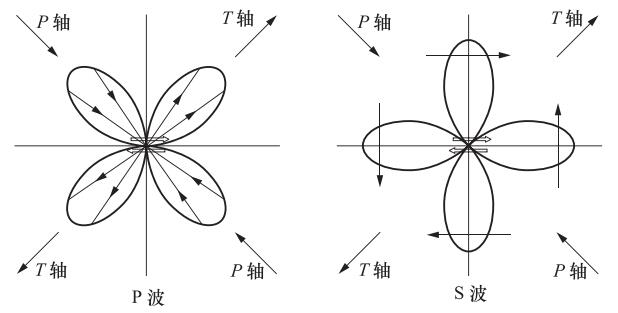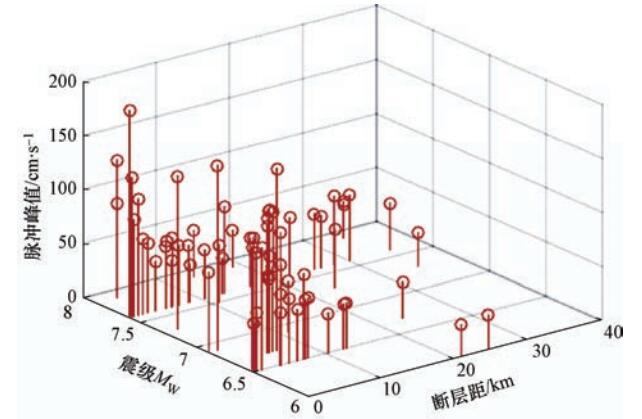Relationship between Near-fault Velocity Pulse and Focal Mechanism
-
摘要: 本文初步分析了近断层速度脉冲的成因和特点,主要包括方向性效应与滑冲效应,并通过中国台湾集集地震的脉冲记录,分析了断层破裂方向和位移大小等震源参数对脉冲强度的影响。此外,基于有限移动源理论,说明了断层辐射与速度脉冲分布的关系,并探讨了利用运动学震源模型研究近断层地震动对速度脉冲影响的技术路线;评述了7种典型的等效速度脉冲模型,建议进一步研究等效速度脉冲函数与震源机制之间的关系。最后,简述了不同类型的断层引起速度脉冲的差异,并推测了产生脉冲型地震动的下限条件,同时展望该研究在地震预警方面的可能性。Abstract: This paper preliminary analyzed the causes and characteristics of the near-fault velocity pulse, including the directivity effect and fling-step effect. The influence of source parameters, such as fault rupture direction and displacement on pulse intensity, is analyzed by using the pulse records of the Chi-Chi earthquake. Based on the theory of finite displacement source, the relationship between fault radiation and velocity pulse distribution is described, and the technical route to study the influence of near-fault ground motion on the velocity pulse by the kinematic source model is discussed. Seven typical equivalent velocity pulse models are reviewed. It is suggested to further study the relationship between the equivalent velocity pulse function and the focal mechanism. The different faults will cause differences in velocity pulses, and the lower limit condition of pulse-type ground motion is deduced. The possibility of the application in earthquake warning is expected.
-
图 3 剪切位错点源的P波和S波辐射图型(Hirasawa等,1965)
Figure 3. Radiation patterns of P-wave and S-wave of shear dislocation source (Hirasawa et al., 1965)
表 1 集集地震中脉冲型记录的主要参数
Table 1. Parameters of selected velocity pulses from the Chi-Chi earthquake
台站代码 纬度/°N 经度/°E 断层距/km 震中距/km 脉冲峰值/cm·s-1 脉冲周期/s TCU076 23.908 120.676 2.8 16 63.7 4 TCU075 23.983 120.678 0.9 20.7 88.4 5.1 TCU065 24.059 120.691 0.6 26.7 127.7 5.7 TCU082 24.148 120.676 5.2 36.2 56.1 9.2 TCU054 24.161 120.675 5.3 37.6 60.9 10.5 TCU049 24.179 120.69 3.8 38.9 44.8 11.8 TCU052 24.198 120.739 0.7 39.6 183.2 12 TCU056 24.159 120.624 10.5 39.7 43.5 12.9 TCU101 24.24 120.709 2.1 45.1 68.4 10 TCU060 24.225 120.644 8.5 45.4 33.7 12 TCU102 24.249 120.72 1.5 45.6 106.6 9.7 TCU068 24.27 120.765 0.3 47.9 191.1 12.2 TCU136 24.26 120.652 8.3 48.8 51.8 10.3 TCU103 24.309 120.707 6.1 52.4 62.2 8.3 TCU087 24.348 120.773 7.6 55.6 53.7 9 表 2 脉冲型地震的相关参数
Table 2. Relevant parameters of pulse-type earthquakes
地点 日期 震级MW 断层类型 震源深度/km 平均滑移/cm 脉冲记录条数 美国,圣费尔南多 1971-02-09 6.6 逆断层 13.0 58.5 1 美国,帝王谷 1979-10-15 6.5 走滑断层 10.0 30.1 15 美国,惠蒂尔峡谷 1987-10-01 6.0 斜滑断层 14.6 50.5 2 美国,洛马·普雷塔 1989-10-18 6.9 斜滑断层 17.5 108.1 2 美国,兰德斯 1992-06-28 7.3 走滑断层 7.0 242.5 3 美国,北岭 1994-01-17 6.7 逆断层 17.5 78.6 11 日本,阪神 1995-01-16 6.9 走滑断层 17.9 58.8 2 土耳其,科贾埃利 1999-08-17 7.5 走滑断层 16.0 207.2 1 中国,台湾集集 1999-09-20 7.6 逆断层 8.0 238.4 28 中国,汶川 2008-05-12 7.9 逆断层 19.0 322.2 7 -
白现军, 王太兴, 卫鑫等, 2017.近断层速度脉冲对隧洞工程动力响应的影响规律.山东大学学报(工学版), 47(2):14-19. http://d.old.wanfangdata.com.cn/Periodical/sdgydxxb201702003 常莹, 周红, 俞言祥, 2012.汶川地震强地面运动模拟.地震学报, 34(2):224-234. doi: 10.3969/j.issn.0253-3782.2012.02.009 陈学良, 郭金萍, 高孟潭等, 2015.1833年9月6日云南嵩明8级大地震强地面运动数值模拟与震害启示.国际地震动态, (9):180. doi: 10.3969/j.issn.0253-4975.2015.09.180 崔臻, 盛谦, 冷先伦等, 2013.近断层地震动对大型地下洞室群地震响应的影响研究.岩土力学, 34(11):3213-3220, 3228. http://d.old.wanfangdata.com.cn/Periodical/ytlx201311029 高孟潭, 俞言祥, 张晓梅等, 2002.北京地区地震动的三维有限差分模拟.中国地震, 18(4):356-364. doi: 10.3969/j.issn.1001-4683.2002.04.005 郭恩, 周锡元, 彭凌云等, 2012.近断层地震动记录中速度大脉冲及其影响范围.北京工业大学学报, 38(2):243-249. http://www.wanfangdata.com.cn/details/detail.do?_type=perio&id=QK201200090427 郭金萍, 陈学良, 高孟潭等, 2015.运动学震源模型对近断层长周期地震动模拟研究综述.世界地震工程, 31(4):226-235. http://www.cnki.com.cn/Article/CJFDTOTAL-SJDC201504032.htm 胡进军, 谢礼立, 2011.地震破裂的方向性效应相关概念综述.地震工程与工程振动, 31(4):1-8. http://d.old.wanfangdata.com.cn/Periodical/dzgcygczd201104001 黄润秋, 李为乐, 2009.汶川大地震触发地质灾害的断层效应分析.工程地质学报, 17(1):19-28. doi: 10.3969/j.issn.1004-9665.2009.01.003 姜慧, 黄剑涛, 俞言祥等, 2009.地表破裂断层近场速度大脉冲研究.华南地震, 29(2):1-9. doi: 10.3969/j.issn.1001-8662.2009.02.001 蒋连接, 白国良, 2016.不同类型的近断层脉冲型地震动能量特性研究.结构工程师, 32(6):92-96. doi: 10.3969/j.issn.1005-0159.2016.06.014 李春锋, 张旸, 赵金宝等, 2006.台湾集集大地震及其余震的长周期地震动特性.地震学报, 28(4):417-428. doi: 10.3321/j.issn:0253-3782.2006.04.009 李明, 2010.近断层地震动对结构抗震设计的影响研究.哈尔滨: 中国地震局工程力学研究所. http://cdmd.cnki.com.cn/Article/CDMD-85406-2010167512.htm 李新乐, 朱晞, 2003.近场地震速度脉冲效应及模拟模型的研究.中国安全科学学报, 13(12):48-52. doi: 10.3969/j.issn.1003-3033.2003.12.012 李新乐, 朱晞, 2004.近断层地震动等效速度脉冲研究.地震学报, 26(6):634-643. doi: 10.3321/j.issn:0253-3782.2004.06.009 李晓轩, 2016.速度脉冲提取与夹杂对地震动的影响研究.哈尔滨: 中国地震局工程力学研究所. http://www.wanfangdata.com.cn/details/detail.do?_type=degree&id=D01104454 李正芳, 周本刚, 2015.地震断层面上凹凸体和障碍体含义的解析.国际地震动态, (5):22-27. http://d.old.wanfangdata.com.cn/Periodical/gjdzdt201505005 梁瑞军, 蒲武川, 黄斌等, 2016.脉冲型近场地震动的近似模型的比较研究.武汉理工大学学报, 38(4):43-49. http://d.old.wanfangdata.com.cn/Periodical/whgydxxb201604008 刘启方, 袁一凡, 金星等, 2006.近断层地震动的基本特征.地震工程与工程振动, 26(1):1-10. doi: 10.3969/j.issn.1000-1301.2006.01.001 刘启方, 2008.近断层强地震动预测的一些基本问题讨论.世界地震工程, 24(3):94-100. http://d.old.wanfangdata.com.cn/Periodical/sjdzgc200803018 蒲武川, 梁瑞军, 戴枫禹等, 2017.基于三角函数的脉冲型近场地震动的近似模型.振动与冲击, 36(4):208-213. http://d.old.wanfangdata.com.cn/Periodical/zdycj201704033 松浦一树, 大友淳一永田, 高弘小林淳, 2001.台湾9·21集集地震地表地震断层.江娃利, 朱秀芳, 译.地壳构造与地壳应力, (1): 20-34. 陶夏新, 王国新, 2003.近场强地震动模拟中对破裂的方向性效应和上盘效应的表达.地震学报, 25(2):191-198. doi: 10.3321/j.issn:0253-3782.2003.02.009 田玉基, 杨庆山, 卢明奇, 2007.近断层脉冲型地震动的模拟方法.地震学报, 29(1):77-84. doi: 10.3321/j.issn:0253-3782.2007.01.009 王海云, 谢礼立, 2008.近断层地震动模拟现状.地球科学进展, 23(10):1043-1049. doi: 10.3321/j.issn:1001-8166.2008.10.006 韦韬, 赵凤新, 张郁山, 2006.近断层速度脉冲的地震动特性研究.地震学报, 28(6):629-637. doi: 10.3321/j.issn:0253-3782.2006.06.008 谢俊举, 温增平, 李小军等, 2012.基于小波方法分析汶川地震近断层地震动的速度脉冲特性.地球物理学报, 55(6):1963-1972. http://d.old.wanfangdata.com.cn/Periodical/dqwlxb201206017 许力生, 陈运泰, 2002.震源时间函数与震源破裂过程.地震地磁观测与研究, 23(6):1-8. doi: 10.3969/j.issn.1003-3246.2002.06.001 袁一凡, 田启文, 2012.工程地震学.北京:地震出版社. 张振国, 孙耀充, 徐建宽等, 2014.2014年8月3日云南鲁甸地震强地面运动初步模拟及烈度预测.地球物理学报, 57(9):3038-3041. http://qikan.cqvip.com/article/detail.aspx?id=662579496 Alavi B., Krawinkler H., 2000. Consideration of near-fault ground motion effects in seismic design. In: Proceedings of the 12th World Conference on Earthquake Engineering. Auckland, New Zealand: New Zealand National Society for Earthquake Engineering. Aoi S., Fujiwara H., 1999. 3D finite-difference method using discontinuous grids. Bulletin of the Seismological Society of America, 89(4):918-930. http://d.old.wanfangdata.com.cn/NSTLQK/NSTL_QKJJ027805603/ Baker J. W., 2007. Quantitative classification of near-fault ground motions using wavelet analysis. Bulletin of the Seismological Society of America, 97(5):1486-1501. doi: 10.1785/0120060255 Benioff H., 1955. Mechanism and strain characteristics of the White Wolf fault as indicated by the aftershock sequence. In: Earthquakes in Kern County, California during 1955. California: California Division of Mines, 171: 199-202. Ben-Menahem A., 1961. Radiation of seismic surface-waves from finite moving sources. Bulletin of the Seismological Society of America, 51(3):401-435. http://cn.bing.com/academic/profile?id=ee5cf54eb6a03f516bbf846c68bca61e&encoded=0&v=paper_preview&mkt=zh-cn Beresnev I. A., Atkinson G. M., 1998. FINSIM——a FORTRAN program for simulating stochastic acceleration time histories from finite faults. Seismological Research Letters, 69(1):27-32. doi: 10.1785/gssrl.69.1.27 Chen K. C., 2004. An observation of rupture pulses of the 20 September 1999 Chi-Chi, Taiwan, earthquake from near-field seismograms. Bulletin of the Seismological Society of America, 91(5):1247-1254. doi: 10.1785/0120000716 Coutant O., Virieux J., Zollo A., 1995. Numerical source implementation in a 2D finite difference scheme for wave propagation. Bulletin of the Seismological Society of America, 85(5):1507-1512. Dickinson B. W., Gavin H. P., 2011. Parametric statistical generalization of uniform-hazard earthquake ground motions. Journal of Structural Engineering, 137(3):410-422. doi: 10.1061/(ASCE)ST.1943-541X.0000330 Fayjaloun R., Causse M., Voisin C., et al., 2016. Spatial variability of the directivity pulse periods observed during an earthquake. Bulletin of the Seismological Society of America, 107(1):308-318. http://adsabs.harvard.edu/abs/2017BuSSA.107..308F Frankel A., 1993. Three-dimensional simulations of ground motions in the San Bernardino Valley, California, for hypothetical earthquakes on the San Andreas Fault. Bulletin of the Seismological Society of America, 83(4):1020-1041. http://cn.bing.com/academic/profile?id=c20b664a9af6ed676edf32e0f8f82bb0&encoded=0&v=paper_preview&mkt=zh-cn Hanks T. C., Kanamori H., 1979. A moment magnitude scale. Journal of Geophysical Research:Solid Earth, 84(B5):2348-2350. doi: 10.1029/JB084iB05p02348 Heaton T. H., Hall J. F., Wald D. J., et al., 1995. Response of high-rise and base-isolated buildings to a hypothetical MW 7.0 blind thrust earthquake. Science, 267(5195):206-211. doi: 10.1126/science.267.5195.206 Hirasawa T., Stauder W., 1965. On the seismic body waves from a finite moving source. Bulletin of the Seismological Society of America, 55(2):237-262. Ilan A., Ungar A., Alterman Z., 1975. An improved representation of boundary conditions in finite difference schemes for seismological problems. Geophysical Journal of the Royal Astronomical Society, 43(3):727-745. doi: 10.1111/gji.1975.43.issue-3 Irikura K., Kamae K., 1999. Strong ground motions during the 1948 Fukui earthquake-estimation of broad-band ground motion using a hybrid simulation technique. Zisin:Journal of the Seismological Society of Japan, 52(1):129-150. doi: 10.4294/zisin1948.52.1_129 Kalkan E., Kunnath S. K., 2012. Effects of fling step and forward directivity on seismic response of buildings. Earthquake Spectra, 22(2):367-390. http://www.wanfangdata.com.cn/details/detail.do?_type=perio&id=JJ025064957 Kurahashi S., Irikura K., 2011. Source model for generating strong ground motions during the 2011 off the Pacific coast of Tohoku earthquake. Earth, Planets and Space, 63:11. http://www.wanfangdata.com.cn/details/detail.do?_type=perio&id=JJ0224826874 Lay T., Wallace T. C., 1995. Modern global seismology. New York:Academic Press. Makris N., Black B., 2003. Dimensional analysis of inelastic structures subjected to near fault ground motions. Berkeley, California: Earthquake Engineering Research Center, University of California. Mallat S., 1999. A wavelet tour of signal processing:the sparse way. 3rd ed. New York:Academic Press. Mavroeidis G. P., 2003. A mathematical representation of near-fault ground motions. Bulletin of the Seismological Society of America, 93(3):1099-1131. doi: 10.1785/0120020100 Menun C., Fu Q., 2002. An analytical model for near-fault ground motions and the response of SDOF systems. In: Proceedings of the 7th US National Conference on Earthquake Engineering. Boston, MA: Mira Digital Publishing. Mikumo T., Hirahara K., Miyatake T., 1987. Dynamical fault rupture processes in heterogeneous media. Tectonophysics, 144(1-3):19-36. doi: 10.1016/0040-1951(87)90006-0 Miyatake T., 1980. Numerical simulations of earthquake source process by a three-dimensional crack model. Part Ⅰ. Rupture process. Journal of Physics of the Earth, 28(6):565-598. doi: 10.4294/jpe1952.28.565 Motazedian D., 2005. Stochastic finite-fault modeling based on a dynamic corner frequency. Bulletin of the Seismological Society of America, 95(3):995-1010. doi: 10.1785/0120030207 Oglesby D. D., Archuleta R. J., 1997. A faulting model for the 1992 Petrolia earthquake:Can extreme ground acceleration be a source effect? Journal of Geophysical Research:Solid Earth, 102(B6):11877-11897. doi: 10.1029/97JB00475 Sekiguchi H., Irikura K., Iwata T., 2000. Fault geometry at the rupture termination of the 1995 Hyogo-ken Nanbu earthquake. Bulletin of the Seismological Society of America, 90(1):117-133. doi: 10.1785/0119990027 Shahi S. K., Baker J. W., 2011. An empirically calibrated framework for including the effects of near-fault directivity in probabilistic seismic hazard analysis. Bulletin of the Seismological Society of America, 101(2):742-755. doi: 10.1785/0120100090 Somerville P., Graves R., 1993. Conditions that give rise to unusually large long period ground motions. Structural Design of Tall Buildings, 2(3):211-232. doi: 10.1002/tal.v2:3 Somerville P., Irikura K., Graves R., et al., 1999. Characterizing crustal earthquake slip models for the prediction of strong ground motion. Seismological Research Letters, 70(1):59-80. doi: 10.1785/gssrl.70.1.59 Somerville P., 2002. Characterizing near fault ground motion for the design and evaluation of bridges. In: Proceedings of the 3rd National Seismic Conference & Work shop on Bridges & Highways. Buffalo, NY: State University of New York. Tessmer E., 2000. Seismic finite-difference modeling with spatially varying time steps. Geophysics, 65(4):1290-1293. doi: 10.1190/1.1444820 Theodoulidis N., Grendas I., 2016. Near fault velocity pulse estimation:The Cephalonia Feb.3, 2014 earthquake (M 6.0). Bulletin of the Geological Society of Greece, 50(3):1453. Wald D. J., Graves R. W., 1998. The seismic response of the Los Angeles basin, California. Bulletin of the Seismological Society of America, 88(2):337-356. http://gji.oxfordjournals.org/cgi/ijlink?linkType=ABST&journalCode=ssabull&resid=88/2/337 Wells D. L., Coppersmith K. J., 1994. New empirical relationships among magnitude, rupture length, rupture width, rupture area, and surface displacement. Bulletin of the Seismological Society of America, 84(4):974-1002. http://cn.bing.com/academic/profile?id=150c7e5c280a023d24460e3ba759c397&encoded=0&v=paper_preview&mkt=zh-cn -




 下载:
下载:




